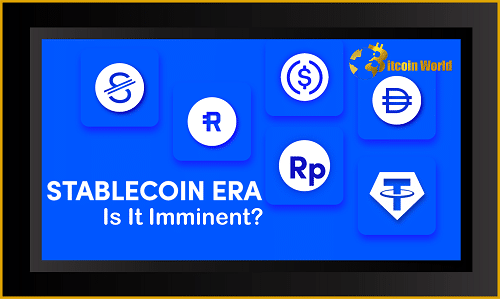The cryptocurrency landscape is in constant flux, but one thing remains clear: stablecoins have fundamentally altered how we interact with digital assets. Think back to the early days of crypto trading – the friction of moving between fiat and volatile cryptocurrencies was a significant hurdle. Then came USDT, offering a bridge, a stable harbor in the often stormy seas of the crypto market. But recent events, particularly the dramatic collapse of Terra’s LUNA and its associated stablecoin UST, have cast a long shadow, prompting serious questions about the very nature and future of these digital dollars. Is this the beginning of the end for stablecoins, or a necessary shake-up paving the way for a more robust future?
The Earth Shattering Event: Understanding the Luna Collapse
The implosion of Terra’s LUNA and UST sent shockwaves throughout the crypto world. It wasn’t just another market dip; it was a systemic failure that exposed the vulnerabilities of algorithmic stablecoins. Unlike asset-backed stablecoins like USDT or USDC, which claim to hold reserves of traditional currencies or other assets, algorithmic stablecoins rely on complex mechanisms and code to maintain their peg to a fiat currency, typically the US dollar. The Terra ecosystem attempted to maintain UST’s dollar peg through a mint-and-burn mechanism involving its sister token, LUNA. When confidence in UST faltered, a cascade of selling ensued, leading to a hyperinflationary spiral of LUNA and the ultimate collapse of both tokens. This event served as a stark reminder of the risks associated with complex and not fully understood financial instruments.
Can Stablecoins Recover and Thrive After Such a Setback?
Despite the Terra debacle, the fundamental need for stablecoins within the crypto ecosystem remains. Imagine navigating the world of decentralized finance (DeFi) without a stable way to park your assets or facilitate trades. Stablecoins offer a crucial on-ramp and off-ramp between the traditional financial system and the often volatile world of cryptocurrencies. They provide:
- Stability in a volatile market: During periods of market uncertainty, stablecoins offer a safe haven for investors looking to preserve their capital without converting back to fiat.
- Efficient trading pairs: Stablecoins are frequently used as base pairs on cryptocurrency exchanges, facilitating faster and more cost-effective trading.
- Seamless DeFi participation: Lending, borrowing, and yield farming in DeFi protocols often rely on stablecoins for their underlying liquidity and stability.
- Potential for payments: While still in its early stages, stablecoins hold the potential to revolutionize payments, offering faster and cheaper transactions compared to traditional methods.
Navigating the Current Landscape: How Can Stablecoins Rise Again?
The key to the resurgence of stablecoins lies in building trust and demonstrating resilience. Here’s how they can navigate the current adversity:
Focusing on Transparency and Reserves
The lack of transparency surrounding the reserves of some stablecoins has been a major point of contention. Moving forward, a greater emphasis on regular, independent audits and clear disclosure of backing assets is crucial. Investors need to have confidence that their stablecoins are indeed backed by real-world assets.
Moving Away from Algorithmic Models (For Now)
The failure of Terra has understandably shaken confidence in algorithmic stablecoins. While the concept might hold promise in the future with more robust mechanisms, the immediate focus should shift towards proven, asset-backed models. This doesn’t necessarily mean the end of innovation in the stablecoin space, but a recalibration towards more established and understood approaches.
Increased Regulatory Scrutiny – A Necessary Step?
The collapse of Terra has undoubtedly caught the attention of regulators worldwide. While some in the crypto space might view regulation with apprehension, it could ultimately be beneficial for the long-term health and adoption of stablecoins. Clear regulatory frameworks can provide clarity, build trust, and protect consumers. The focus should be on creating sensible regulations that foster innovation while mitigating systemic risks.
Exploring Diverse Use Cases Beyond Trading
While trading remains a primary use case, the true potential of stablecoins extends far beyond. Consider these possibilities:
- Cross-border payments: Stablecoins can facilitate faster and cheaper international money transfers, bypassing traditional banking systems.
- Remittances: For individuals sending money home, stablecoins offer a more efficient and cost-effective alternative to traditional remittance services.
- Payroll and salaries: Businesses could potentially use stablecoins to pay employees globally, reducing transaction fees and delays.
- Micropayments: The low transaction costs associated with some blockchains could make stablecoins ideal for small, frequent payments.
Challenges and Roadblocks Ahead
The path forward for stablecoins isn’t without its hurdles:
- Regulatory uncertainty: The lack of consistent global regulations creates uncertainty and can hinder widespread adoption.
- Centralization concerns: The concentration of stablecoin issuance among a few major players raises concerns about potential centralization and control.
- Scalability issues: Some blockchain networks may struggle to handle the transaction volume required for mass stablecoin adoption.
- Security risks: Like any digital asset, stablecoins are susceptible to hacking and theft.
The Future is Stable (Coin)?
Despite the recent turmoil, stablecoins remain a vital component of the cryptocurrency ecosystem. The collapse of Terra served as a painful but necessary lesson, highlighting the importance of robust mechanisms, transparency, and sound financial principles. As the industry matures and regulators provide clearer guidelines, we can expect to see a more resilient and diverse stablecoin landscape emerge. The focus will likely shift towards well-regulated, asset-backed stablecoins, paving the way for broader adoption in various sectors. While the dream of a purely algorithmic stablecoin might be on hold for now, the underlying need for stable digital currencies persists. The future of finance is increasingly digital, and stablecoins are poised to play a crucial role in bridging the gap between the old and the new, facilitating a more efficient and accessible financial world.
Disclaimer: The information provided is not trading advice, Bitcoinworld.co.in holds no liability for any investments made based on the information provided on this page. We strongly recommend independent research and/or consultation with a qualified professional before making any investment decisions.


